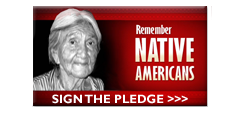
 
|
 |
When Emergency Strikes
All of NRC’s work is done through its Program Partners. These are Native American volunteers who live on the reservations, identify what their community’s need, and administer the distribution of goods through established reservation programs. They typically request support for programs that involve education, job training, life skills, healthcare, and other basic necessities. Program Partners also request support when environmental emergencies strike and put people in their communities at risk.
On November 4, 2008, while most of this country was focused on the Presidential election, people living in remote areas on the Pine Ridge and Rosebud Reservations were preparing for a winter storm. For 2 days, this blizzard pounded the Northern Plains, crippling some reservation communities. In the community of Wanblee, families sought shelter at the local school. Another 25 miles east, in the community of Corn Creek, an elderly grandmother ran a high risk in order to help for her family…
Mary and Thomas are very self-sufficient. They mainly rely on each other for support and survival and are not accustomed to asking others for help. They are lifelong caretakers for their mentally handicapped grandson, who is unable to do much for himself. Mary is petite and fragile, so Thomas does most of the manual work such as keeping their fire going. Like many in their community, they cook and heat with the same stove.
When the winter blizzard hit on November 5, it produced over a foot of snow. Winds gusted up to 60 mph, and the snow drifted higher than some rooftops. At 81, Thomas braved the storm to carry in more firewood. Undoubtedly hoping to make fewer trips outdoors, Thomas was carrying more wood than usual, when he tripped and fell in the snow. He broke two ribs and his ankle. Thomas dragged himself back to the house, with the wood supply in tow.
With things now turned desperate, Mary had to find a way to get someone’s attention. Thomas was injured. They had no running water, electricity, phone, or neighbors. The tribal offices were closed, and travel advisories were severe.
At age 82, Mary’s only recourse was to crawl down the long run leading to their house and put up a sign that read simply “HELP.” She posted the sign on Thursday; it was Monday before any help came. Their rescuer took Thomas to the nearest clinic, some 45 miles away.
This blizzard left many other Native American families in dire straits. In the aftermath, a Rosebud Program Partner called on National Relief Charities for help. NRC answered this partner’s call by delivering emergency provisions (blankets, water, food, energy bars, and personal hygiene items), which were distributed during home visits by the Program Partner and service workers. Mary and Thomas were among the families that were able to receive these supplies in their time of need. NRC also sent emergency provisions to Pine Ridge Program Partners who called.
NRC’s Environmental Emergency service is designed for just such weather emergencies. We responded to 9 separate blizzards, tornadoes, hurricanes, floods, and fires in 2008. NRC is also a member of SD-VOAD (South Dakota Volunteer Organizations Active in Disaster), where we coordinate efforts with the American Red Cross and other disaster relief organizations to respond during a crisis.
Download PDF >>
|
 |


